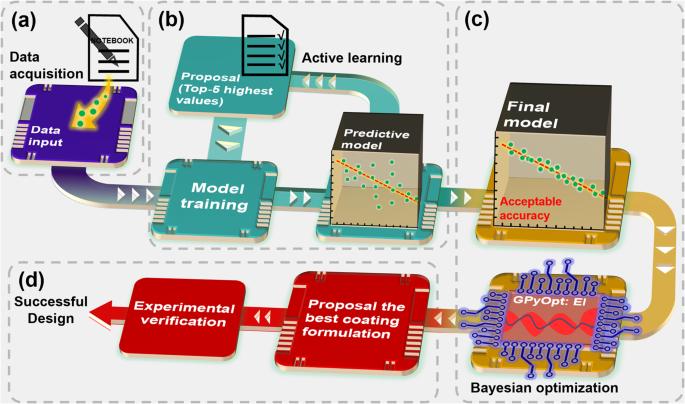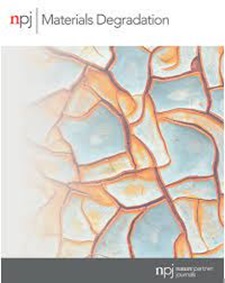机器学习辅助发现用于防腐的高效自修复环氧涂料
IF 6.6
2区 材料科学
Q1 MATERIALS SCIENCE, MULTIDISCIPLINARY
引用次数: 0
摘要
机器学习是快速开发高性能功能材料的有力手段。在本研究中,我们提出了一种机器学习工作流程,用于预测含有 ZIF-8@Ca 微填料的自愈合环氧涂层的耐腐蚀性。采用正交拉丁平方法研究了聚醚胺固化剂的分子量、聚醚胺与环氧树脂的摩尔比、氢键单元(UPy-D400)的摩尔含量以及固体微填料(ZIF-8@Ca 微填料)的质量含量对划痕涂层的低阻抗模量(lg|Z|0.01Hz)值的影响,生成了 32 个初始数据集。机器学习工作流程分为两个阶段:在第一阶段,比较了五个模型,并选择随机森林(RF)模型进行主动学习。经过 5 个周期的主动学习,RF 模型达到了良好的预测精度:决定系数 (R2) = 0.709,平均绝对百分比误差 (MAPE) = 0.081,均方根误差 (RMSE) = 0.685 (lg(Ω-cm2)) 。在第二阶段,通过贝叶斯优化确定了最佳涂层配方。最后,电化学阻抗谱(EIS)结果表明,与完整涂层((4.63 ± 2.08) × 1011 Ω-cm2)相比,修复涂层的|Z|0.01Hz 值高达 (4.40 ± 2.04) × 1011 Ω-cm2。此外,经过 60 天的中性盐雾测试后,修复涂层的腐蚀程度极小,附着力损失为 3.3%。本文章由计算机程序翻译,如有差异,请以英文原文为准。

Machine learning assisted discovery of high-efficiency self-healing epoxy coating for corrosion protection
Machine learning is a powerful means for the rapid development of high-performance functional materials. In this study, we presented a machine learning workflow for predicting the corrosion resistance of a self-healing epoxy coating containing ZIF-8@Ca microfillers. The orthogonal Latin square method was used to investigate the effects of the molecular weight of the polyetheramine curing agent, molar ratio of polyetheramine to epoxy, molar content of the hydrogen bond unit (UPy-D400), and mass content of the solid microfillers (ZIF-8@Ca microfillers) on the low impedance modulus (lg|Z|0.01Hz) values of the scratched coatings, generating 32 initial datasets. The machine learning workflow was divided into two stages: In stage I, five models were compared and the random forest (RF) model was selected for the active learning. After 5 cycles of active learning, the RF model achieved good prediction accuracy: coefficient of determination (R2) = 0.709, mean absolute percentage error (MAPE) = 0.081, root mean square error (RMSE) = 0.685 (lg(Ω·cm2)). In stage II, the best coating formulation was identified by Bayesian optimization. Finally, the electrochemical impedance spectroscopy (EIS) results showed that compared with the intact coating ((4.63 ± 2.08) × 1011 Ω·cm2), the |Z|0.01Hz value of the repaired coating was as high as (4.40 ± 2.04) × 1011 Ω·cm2. Besides, the repaired coating showed minimal corrosion and 3.3% of adhesion loss after 60 days of neutral salt spray testing.
求助全文
通过发布文献求助,成功后即可免费获取论文全文。
去求助
来源期刊

npj Materials Degradation
MATERIALS SCIENCE, MULTIDISCIPLINARY-
CiteScore
7.80
自引率
7.80%
发文量
86
审稿时长
6 weeks
期刊介绍:
npj Materials Degradation considers basic and applied research that explores all aspects of the degradation of metallic and non-metallic materials. The journal broadly defines ‘materials degradation’ as a reduction in the ability of a material to perform its task in-service as a result of environmental exposure.
The journal covers a broad range of topics including but not limited to:
-Degradation of metals, glasses, minerals, polymers, ceramics, cements and composites in natural and engineered environments, as a result of various stimuli
-Computational and experimental studies of degradation mechanisms and kinetics
-Characterization of degradation by traditional and emerging techniques
-New approaches and technologies for enhancing resistance to degradation
-Inspection and monitoring techniques for materials in-service, such as sensing technologies
 求助内容:
求助内容: 应助结果提醒方式:
应助结果提醒方式:


